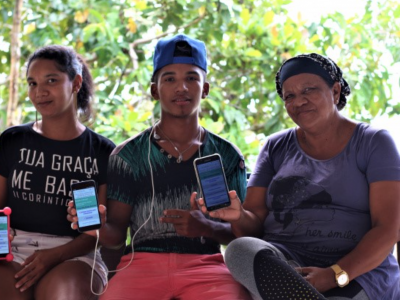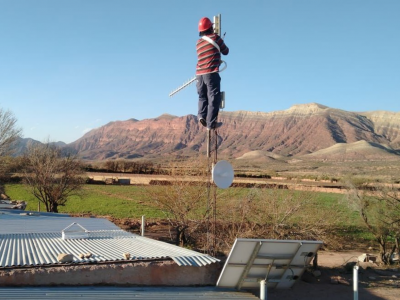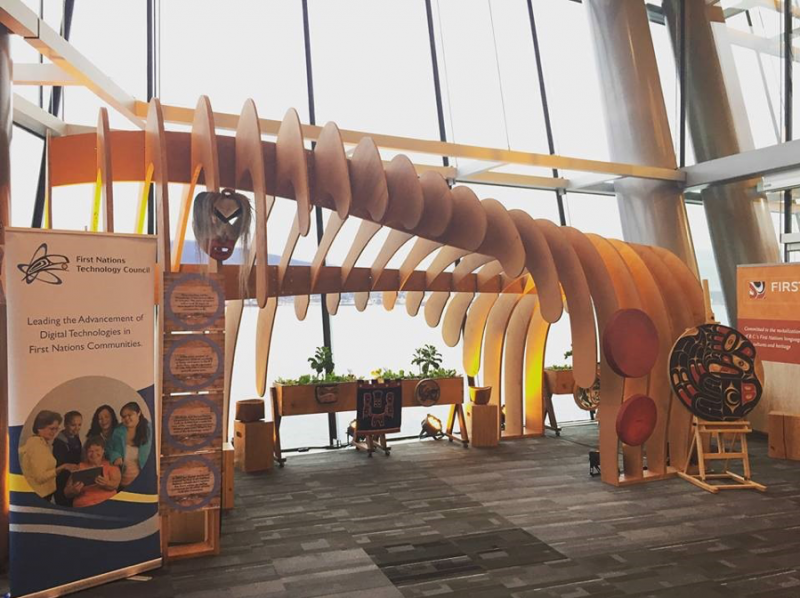
Promotion/Information display. Published with permission from First Nations Technology Council (British Columbia).
Rising Voices (RV) is partnering with the Association for Progressive Communications (APC) which produced the 2018 Global Information Society Watch (GISWatch) focusing on community networks defined as “communication networks built, owned, operated, and used by citizens in a participatory and open manner.” Over the next several months, RV will be republishing versions of the country reports highlighting diverse community networks from around the world.
This country report was written by Rob McMahon from the First Mile Project based in Fredericton, New Brunswick, Canada. Please visit the GISWatch website for the full report which is also available under a CC BY 4.0 license.
First Nations are leading local and regional community networking initiatives in Canada. From trenching fibre backhaul along gravel roads to installing Wi-Fi antennas on the roofs of homes and businesses, community champions and regional technology organisations are connecting rural, remote and Northern regions. These projects respond to persistent divides, demonstrating ways that communities drive infrastructure development while retaining ownership and control of networks and services. Many of these indigenous community networks have been in operation for years, and range from local internet service providers (ISPs) to complex regional organisations that provide services to multiple communities.
Along with the passion of community networking champions, indigenous community networks involve an array of other activities, such as seeking policy support, engaging in technical development, and responding to high demand for digital services. Lower-cost equipment can now be easily transported and set up by local technicians. If adequate backhaul is in place, these networks offer robust internet services to households and organisations. Once service becomes available, people quickly adopt online education, health and e‑commerce applications, social media platforms like Facebook and Twitter, and mobile apps. For example, the Atlantic Canada First Nations Help Desk based in Membertou First Nation is developing a series of language apps to protect and revitalise the Mi’kmaw language.

Mi’kmaw language app. Published with permission from Atlantic Canada’s First Nation Help Desk.
Adoption in these communities reflects a “whole community” understanding of and approach to digital technologies for social and economic development that counters models focused on “individual” and “household” metrics. A broader ecology of community support enables local innovators to build, shape, manage, operate and utilise these tools – activities reflected in networking projects such as the Mamwapowin Technology Society in Maskwacis, Alberta. Although it is located less than an hour from the province’s capital of Edmonton, few commercial internet services are available in Maskwacis. Many residents are unable to afford residential services, which can cost up to CAD 132 (roughly USD 100) a month – an expensive service in a region with few employment opportunities.
In 2016 Bruce Buffalo, a member of Samson Cree Nation, set up a free Wi-Fi hotspot that redistributed his personal internet connection to several local neighbourhoods. The self-taught technician invested his own money to build a wireless system with two switches and an online access portal. Since then, Bruce has expanded the network, upgraded his wireless equipment, and founded Mamwapowin as a non-profit. He is now working with Maskwacis Cultural College to secure a 100 Mbps backhaul link, which will provide bandwidth he can use to connect Wi-Fi users to public safety resources, community services and online education. Once connectivity has been enhanced to support video, Bruce would like to create a community tech hub where he can bring all ages together to learn how to use the internet for education opportunities, business development, and to explore technology in an open learning space. Bruce is also engaged in public outreach about his project, and is currently fundraising to expand it. He has given presentations to groups including the Canadian Internet Registration Authority (CIRA) to share his project as a potential template for others.
Mamwapowin Technology Society is just one recent example of many digital innovations taking place in First Nations across Canada – many more indigenous community networks have been in place for years, with some operating since the earlier days of the internet, almost 30 years ago. In the next section, we highlight some of the political, economic and policy conditions that support and constrain their work.
Enabling digital self-determination: Political, economic and policy contexts
In Canada, indigenous community networking advocates have fought hard to establish and sustain policy and regulatory frameworks that enable digital self-determination. Almost 20 years ago, the National Broadband Task Force released a report (2001) that identified the digital access divides facing rural, remote, Northern and indigenous communities, and proposed a national broadband strategy to connect all communities – with priority placed on affordable access. Five years later, the Canadian Telecommunications Policy Review Panel report (2006) noted that community networks provide both technological and social infrastructures for digital technology access, adoption and use. Starting in the mid-1990s and continuing to the present, government departments have established funds to encourage the deployment and operations of infrastructure in under-served regions.
But despite billions of public dollars invested, many indigenous communities still lack adequate, affordable access. Canada still does not have a national broadband strategy, and First Nations, Inuit and Métis communities continue to be challenged with limited connectivity. Many people living in indigenous communities are struggling to pay the high costs of accessing and using digital technologies – though research also illustrates they are eager adopters if connectivity is affordable, reliable and meets their needs.
In recent years the government of Canada has paid increasing attention to the challenge of rural and remote digital divides, and to the First Nations community networks working to address it. To drive infrastructure deployment, the Canadian Radio-television and Telecommunications Commission (CRTC) established a new basic service objective (BSO) for broadband in December 2016. This new standard recommends speeds of 50 Mbps download/10 Mbps upload, among other conditions. It was established after years of advocacy by indigenous and public interest groups in CRTC proceedings concerning access in Northern territories, including 2012 hearings on Northwestel’s Modernization Plan and a 2014 inquiry on satellite services. Unfortunately, the government of Canada and the major telecom providers serving remote and rural communities continue to deliver connectivity services and infrastructure capable of less than the CRTC’s recommended speeds.
With regard to affordability, the CRTC has generally encouraged competition, though it has stepped in to regulate retail rates in some remote/Northern regions that lack competition. The importance of affordable services was raised in proceedings leading to the BSO decision – with a debate emerging between parties calling for an affordability subsidy for individual consumers, and groups who responded that regulations should instead focus on encouraging funds for community networks. The “whole community” approach noted earlier encourages a community-wide funding regime that supports the required networking solutions for everyone.
The government has also set up a series of broadband funding programmes. Most recently these include the CND 500-million Connect to Innovate (CTI) programme managed by Innovation, Science and Economic Development Canada (ISED) to establish regional backhaul networks, and a broadband fund currently being set up by the CRTC. The CTI fund contributed to several major projects in Canada’s North, including the Mackenzie Valley Fibre Link in the Northwest Territories, the Dempster fibre project in the Yukon, and funding for satellite infrastructure in Nunavut. Despite these gains, critics note these projects are operated by incumbents rather than community networks, and lack a public definition of “open access” requirements.
Importantly, after pressure from indigenous and public interest groups, infrastructure funding programmes were made available to non-profits, cooperatives and community-based organisations. Examples of First Nations CTI projects include initiatives led by Matawa First Nations in Ontario, Clear Sky Connections in Manitoba, and Arrow Technology Group in Alberta. The deployment, operations and sustainability of these community networks require a complex balance between local innovation, regional cooperation, and supportive policy and regulatory conditions. As noted in the 2017 GISWatch country report for Canada, residents of affected communities must be involved in the provision of digital services. They should not be restricted to act only as consumers of broadband – they can also contribute as producers, owners and operators. Such opportunities utilise broadband not just as an enabler for economic development in other industries and services, but also as a locally owned and managed resource in and of itself.
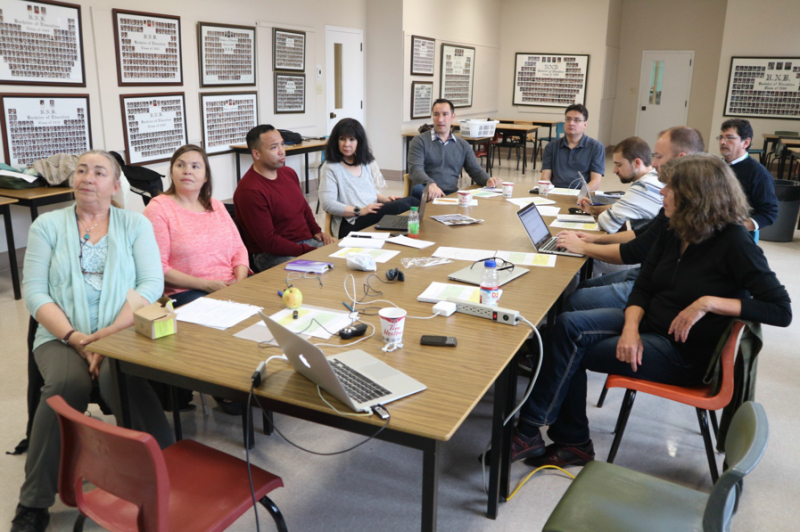
The FNI-FMCC team from across Canada at a strategy meeting at the University of New Brunswick, Fredericton, October 2017.
This perspective reflects “first-mile” solutions in the design, development and operations of telecommunication infrastructure and services – that is, those which invest in connections and organisations rooted in affected communities and regions. Such an approach is proposed for communities that lack a business case for private sector companies to build and operate required infrastructure and services. Locally oriented first-mile solutions contrast with “last-mile” initiatives that focus on upgrades to urban-based infrastructures in the hope that they will eventually serve remote and rural regions. The drive to secure affordability and access through self-determined first-mile broadband development has supported the emergence of indigenous community networks in Canada governed by, and directly accountable to, the communities they serve. For example, the Kuhkenah Network (K-Net) began their local broadband network development work in 2000.
Without a means to interconnect with regional backhaul networks, local initiatives remain points of isolation. Local providers can interconnect through “open access” infrastructure, but a clear definition of open access is often lacking – leaving backhaul providers indirect means to obstruct adequate interconnection, such as by charging high rates for access. This issue was debated at a 2017 CRTC proceeding, after which the Commission denied an application by Northwestel requesting forbearance from the regulation of its Wholesale Connect service in the communities served by the Mackenzie Valley Fibre Link network, since forbearance would not be in the public interest of users in affected communities.
Community wireless providers face a related challenge: while spectrum allocations are regulated by the federal government and sold in auction, licences typically cover huge areas at high cost – leaving smaller providers unable to purchase and utilise wholesale spectrum. Historically, Canada developed the Rural Remote Broadband Systems (RRBS) policy to support spectrum utilisation by small providers servicing rural and remote regions. However, while RRBS “offers a clear case study of a bold policy initiative to bring service to difficult regions and introduce new smaller players into concentrated wireless markets,” over time it failed, due to “speculative license holders, poor economies of scale and, most importantly, faint government support.”
Another challenge relates to the sustainability of community networks. Larger-scale services support broadband-enabled applications such as e‑health and education that also provide steady revenue streams, even in small populations and dispersed communities. To interconnect communities and regions, local systems can link to regional backhaul networks in ways that allow organisations to balance autonomy with cooperation, such as through sharing bandwidth across regions while supporting local service delivery. For example, Opiticiwan First Nation and the regional First Nations Education Council (FNEC) in Quebec set up a fibre optic network to share infrastructure and network support services with public service that sustain the ongoing operation and maintenance of the network. This work reflects the e‑Community Framework developed by Judy Whiteduck in 2010 and endorsed by the national Assembly of First Nations. The framework, illustrated in Figure 1, reflects the important role of community organisations, services and activities in sustaining broadband connectivity. These organisations meet many essential needs, provide sustainable local employment, and support community, social, political and economic development. The First Mile Connectivity Consortium (FMCC) introduced the “whole community” approach to telecom development and funding programmes to ensure communities are able to plan and sustain their local networks to address their needs and priorities.
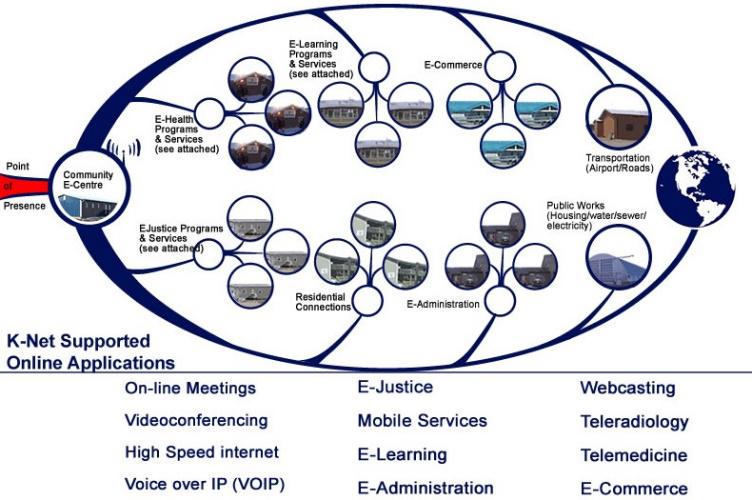
Figure 1: First Nations e-Community Framework
In the next section, we discuss some of the work that community networking advocates are doing to bring these elements of the e‑community together, focusing on the work of the FMCC.
Indigenous regional community intermediary organisations in Canada
On-the-ground innovators like Bruce Buffalo build and operate community networks. But without a means to aggregate on a broader scale, even with funding and regulatory support, local networks can remain insular pockets. Through regional community intermediary organisations, local projects gain a means to exchange knowledge and expertise, achieve economies of scale, and gain more political and economic clout.
In Canada, broadband-focused regional community intermediary organisations include First Nation Councils such as Keewaytinook Okimakanak (which established K-Net – see below), regional governments such as the Kativik Regional Government, and non-profit advocacy groups set up by Northern residents, such as the (now-defunct) Nunavut Broadband Development Corporation. These organisations perform a range of functions, including broadband deployment, operations and maintenance, purchasing, IT support and training, legal and advocacy support, and so on. They play prominent roles in both advocating for and administering ICT infrastructures and services. They represent (and are governed by) groups of communities, acting as mediators between local interests and external entities like government funders or corporations.
Some of these regional organisations have been providing services for decades. For example, K-Net was founded in 1994, during the early years of the internet. Its services, which encompass the whole community framework discussed above, now reach over 80 communities across Ontario and in other provinces. It partners with First Nations, government programmes, telecom transport providers and other groups to facilitate the largest indigenous network across Canada, and probably the world (see Figure 2).
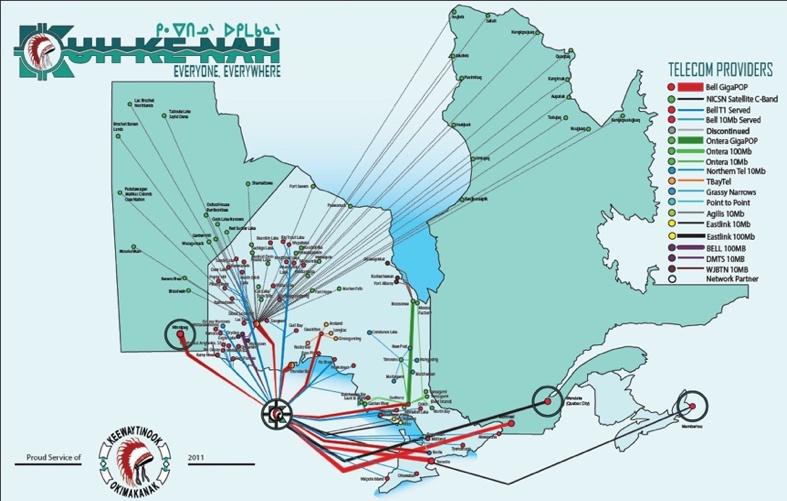
Figure 2: K-Net network map
In 2013, several regional community intermediary organisations united to form a national association called the First Mile Connectivity Consortium. The FMCC’s members collaborate closely to engage in policy and regulatory advocacy, as well as in research, outreach, and digital literacy initiatives. The FMCC’s 11 current members (listed from West to East to North) are:
- First Nations Technology Council (British Columbia)
- First Nations Technical Services Advisory Group Inc. (Alberta)
- Manitoba First Nations Education Resource Centre Inc.
- Clear Sky Connections (Manitoba)
- Broadband Communications North (Manitoba)
- Keewaytinook Okimakanak K-Net Services (Ontario)
- Western James Bay Telecom Network (Northeastern Ontario)
- Matawa First Nations Management (Ontario)
- First Nations Education Council (Quebec)
- Atlantic Canada’s First Nations Help Desk (Atlantic region)
- The Native Communications Society of the Northwest Territories.
Along with participating in the CRTC hearings and ISED funding programmes noted above, and contributing to other government consultations, FMCC members are currently working to support connectivity planning and monitor broadband quality and usage. These initiatives reflect efforts to develop and share appropriate digital literacies that make effective use of telecommunications services and facilities in rural, remote, Northern and indigenous environments. This definition of “digital literacy” extends beyond an individual's ability to use a computer, software like Microsoft Office, or social media – it also supports the planning, management and maintenance of telecommunications infrastructure and services.
This work also aims to train community technicians – an important area of economic development in these regions. For example, the Eeyou Communication Network, a regional non-profit network operating in northern Quebec, has trained technicians, and 33 graduates have found work in ICTs in the Cree communities. In British Columbia, the First Nations Technology Council recently established the Bridging to Technology programme, which focuses on digital skills training and professional development. Other digital literacy initiatives include workshops provided by the Gwich’in Tribal Council in the Northwest Territories and a digital literacy camp developed by Piikani First Nation in Alberta.
Digital literacies also include the ability to conduct internet performance monitoring tests. This is a key issue given the gaps in existing coverage in indigenous regions highlighted by parties like the CRTC, which established a monitoring initiative called SamKnows, and CIRA, which developed an online portal to measure internet performance. The FMCC is working with Northern communities and their regional organisations to pilot a first-mile approach to internet measurement. In northern Ontario, community members are invited to use the KO eCommunity Facebook group to share ideas on how they are using technology in their communities, and to plan together for the future of community networks. In another project, several FMCC member organisations and Cybera (Alberta’s not-for-profit technology accelerator) will use CIRA’s platform to establish a methodology to conduct ongoing community-based internet performance measurement monitoring. These projects aim to highlight the important role that community members play in monitoring and enforcing CRTC basic service obligations.
Conclusion
2018 is an exciting year for indigenous community networks in Canada. Politically, rural and remote broadband is a growing public issue. For example, in April 2018, the House of Commons Standing Committee on Industry, Science and Technology presented its report Broadband Connectivity in Rural Canada: Overcoming the Digital Divide. Among other points, the report provided recommendations to encourage non-traditional network operators to apply for federal funding, including, but not limited to, cooperatives, non-profits, partnerships and local governments. Similar calls for community networking support are seen in CIRA’s report The Gap Between Us: Perspectives on building a better online Canada, which “captures the experiences, opinions and proposed solutions of 70 grassroots organizations across Canada working to make the internet better for Canadians.”
Another key development is the second Indigenous Connectivity Summit, which was hosted by the Internet Society in Edmonton, Alberta and Inuvik, Northwest Territories in October 2018. The summit provides a space for advocates of indigenous connectivity to discuss and debate community networks, and the policy and technical conditions that might enable their widespread growth and sustainability.
Looking ahead, the government of Canada has announced it will launch a review of the Telecommunications Act and the Broadcasting Act. A seven-member panel has been appointed to the review, and public consultations was announced for September 2018. This review will update and modernise the legislative framework, support the principle of net neutrality, and address how to best promote competition and affordability for internet and mobile wireless.
These consultations provide opportunities for indigenous community networks to contribute to policies and regulations impacting on broadband infrastructure and services. Importantly, this work must recognise the range of telecommunications development approaches documented through the First Nations Innovation (FNI) research project at the University of New Brunswick, which concluded in the spring of 2018 after more than 12 years partnering with indigenous regional intermediary organisations across Canada. As a final task of the FNI research project, the partners collaborated in a book celebrating and highlighting the research and advocacy undertaken over the years. This free online publication is titled Stories from the First Mile: Digital technologies in remote and rural Indigenous communities.
For more information regarding action steps to support the continued development and sustainability of indigenous community networks in Canada, please visit the full report on the GISWatch website.

